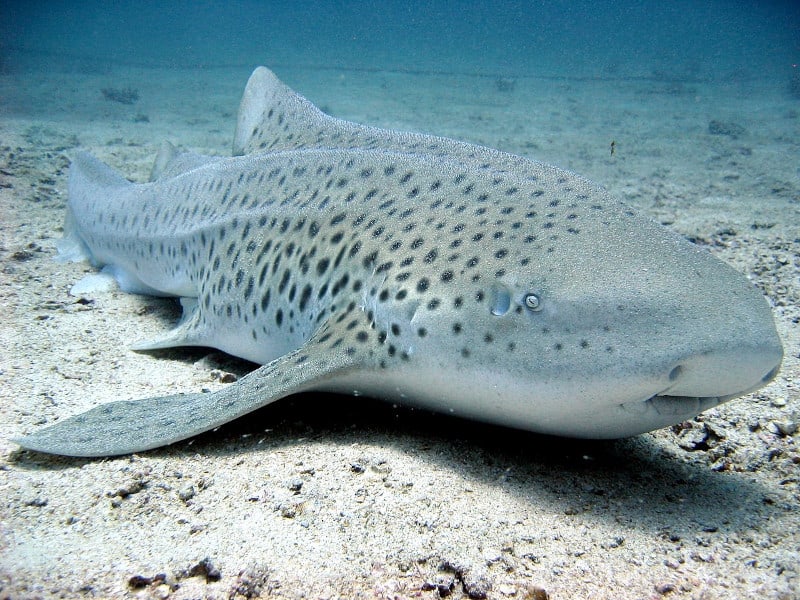Zebra Shark Facts
- In a strange turn of events, this fascinating ocean fish most frequently goes by the unusual, as well as deceptive, common name of the Zebra Shark. Unusually , for the moment, the remarkable sea-dwelling species has no other generally accepted common name.
- Professionals, such as researchers, meanwhile, typically refer to the creature by its scientific name. That term, however, as with many such instances, remains somewhat hard to pronounce. That’s because the fish formal scientific name’s Stegostoma tigrinum.
- The first known official recording of it as a separate and distinct species took place in 1758, due to the efforts of the Dutch zoologist, Albertus Seba. He received the well-deserved accreditation posthumously, however, since the man himself died several years earlier.
- Unfortunately, the population of this amazing creature appears to be declining. Moreover, this regrettable trend seems to hold true throughout the entirety of its known range. The IUCN, therefore, presently lists it as Endangered on its Red List of Threatened Species.
- Presently, the leading culprit for its decline in population continues to be commercial fishing practices. This holds true because the natural wonder continues to be actively sought after across most of its range. It’s principally sought for its meat, liver oil, and fins.
- The impressive Zebra Shark nevertheless faces other threats to its existnce, however. Habitat loss poses an increasing threat, as man intrudes into its domain, of course. The greatest potential threat it faces, though, likely comes in the form of ongoing climate change.
Related Articles
Zebra Shark Physical Description
The Zebra Shark certainly impresses its fair share of those who encounter the creature in its native habitat. It does not do so, however, due to sheer size. That’s because, in that particular respect, this stunning marvel of Nature represents only a roughly average-sized species of its kind.
It does differ from many of its brethren in that regard, however, This holds true due to the fact that this specific species does not display any noticeable degree of the physiological characteristic of sexual dimorphism. This tendency makes distinguishing the two genders quite difficult.
The two sexes therefore present virtually identical sizes and patterns of coloration to the observer. An average body length for a fully mature adult of either sex reaches roughly 8.2 ft (2.5 m). Exceptional specimens, however, do occasionally attain lengths of as much as 11 ft (3.5 m).
In general, the body of this amazing animal manifests a strongly cylindrical shape. The head usually develops as slightly flattened, and possessed of a blunt, short snout. Its eyes also develop as quite small, and appear on the sides of the head. The species further manifests 5 gill slits.
The somewhat confusing name of the Zebra Shark derives from the appearance of the immature individuals. These examples manifest a distinctly different pattern of coloring that the adults. As the common name clearly implies, the immature shark presents stripes, like a zebra.
The adults of the species, meanwhile, develop a distinctly different pattern as they age. Most mature individuals present a light background, typically various shades of tan. This, though, also has a covering of numerous small spots. These markings appear a dark brown to black in color.
- Kingdom: Animalia
- Phylum: Chordata
- Class: Chondrichthyes
- Order: Orectolobiformes
- Family: Stegostomatidae
- Genus: Stegostoma
- Species: S. tigrinum
Zebra Shark Distribution, Habitat, and Ecology
Fortunately, the stunning Zebra Shark appears to be endemic to a relatively wide swathe of the oceans of the world. This further seems to hold true in comparison with many, though, certainly, not all known species of sharks. Yet known range of the fish remains respectable.
More precisely, however, it seems to inhabit specific portions of the Indo-Pacific region. Within that greater range, though, the marvel only makes its home in the tropical waters of the area. That range extends from South Africa, through the Red Sea, to India, and all the way to Australia.
In all the regions of its range that the shark appears in, however, the animal displays decidedly clear preferences for its choice of habitat. In this, it possesses two very specific requirements. The creature only lives within the intertidal zone, and lives as a bottom-dwelling species.
Within that habitation zone, though, the great majority of individuals live their lives in various locations. Specimens appear at maximum recorded depths measuring no more than 203 ft (62 m). Most individuals, in fact, prefer shallower depths. These often swim along the continental shelf.
The Zebra Shark evolved as primarily nocturnal in nature. Most individuals remains comparatively sluggish by day, typically moving very little. These individuals most often appear on the ocean floor, frequently facing into the current. This facilitates their breathing while minimizing movement.
By night, however, the impressive animal transforms into an active, powerful swimmer and hunter. It mainly feeds on small fish, various crustaceans, and possibly sea snakes. Typically a solitary creature, it nevertheless occasionally bands together in large groups for unknown reasons.
Species Sharing Its Region
Check out our other articles on 5 Marvelous Mammals of California, Shoebill, Macquarie Island, Yellow Throated Marten, Parrot’s Beak, Giant Wood Moth, Maned Wolf, Giant Girdled Lizard

